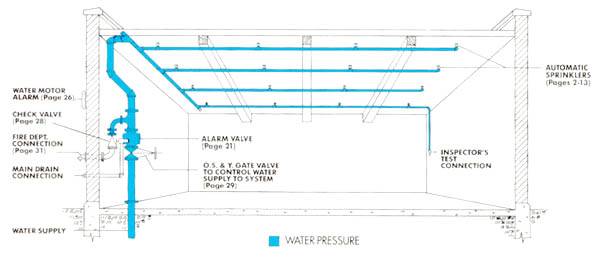01.
Wet Pipe Sprinkler System
Wet pipe sprinkler systems employ automatic sprinklers attached to a piping
system containing water and connected to a water supply so that water
discharges immediately from sprinklers opened by a fire. Wet pipe systems
are the most reliable and simple of all sprinkler systems since no equipment
other than the sprinklers themselves need to operate. Only those sprinklers
which have been operated by heat over the fire will discharge water.

02.
CO2 High Pressure System
CO2 system comprises the following main components:-
a. Liquified CO2 Gas
Carbon Dioxide is a non-flammable, colourless, odourless, non-corrosive,
non-damaging electrically and non-conductive gas. CO2 extinguishes fire
by reducing the concentration of oxygen and / or the gaseous phase of
the fuel in the air to the point where combustion stops. It is utilized
mainly for the protection of :-
· Gaseous and liquid flammable materials
· Electrical hazards
· Engines using gasoline and other flammable fuels
· Ordinary combustibles
· Hazardous solids.
CO2
will NOT extinguish fires where the following materials are actively involved
in the combustion process:-
· Chemicals containing their own oxygen supply
· Reactive metals
· Metal hydrides
b.
CO2 Cylinder Modules
Our CO2 cylinder can be connected to a manifold via a non return valve
to enable individual containers to be removed from the system without
interruption of the general protection. Generally, the cylinders are grouped
in rows in any combination. We recommend a single row or double row arrangement
for economical space utilization.
c. Release Unit
The release and subsequent discharge of the CO2 gas can be effected either
manually and / or automatically.
·
Manual Actuation
The manual release actuation is effected by just pulling the release handle
at the cylinder valve.
· Automatic Actuation
Automatic release occurs according to the fire hazard detected in the
room to be protected as in total flooding or within the immediate vicinity
of the object to the protected as in local application. It can be either
mechanical, pneumatic, electrical or electro-pneumatic.
1.
Mechanical release
The fusible link is mounted onto aa wire rope stretched by weights. Upon
heat application, the fusible links breaks and actuates the release mechanism
at the CO2 cylinder bank.
2. Pneumatic Mechanical Release
The fusible link is mounted onto a wire rope stretched by weights. Upon
heat application, the discharged gas of the pilot cylinder actuates the
release mechanism at the CO2 cylinder bank.
3. Electrical Release
Detectors responding to a fire condition transmit a signal to the detection
panel, which then activate the release mechanism.

Carbon
Dioxide Extinguishing system typical arrangement drawing
Legend :
1. Smoke Detector
2. Heat Detector
3. CO2 Control Panel
4. 24vdc tripping Device
5. fire Curtain
6. Twin Flashing Light
7. Pilot Cylinder
8. Pressure Gauge
9. 24vdc Solenoid Valve
10. Switch Indication to CO2 Panel
11. Manual Discharge Lever
12. Galvanised Steel Cable in Conduit
13. Corner Pulley
14. Angle Bracket
15. Manual Pull Station
16. 68 Litre Carbon Dioxide Cylinder
17. 20mm Discharge Flow Hose C/W check valve
18. 12mm Pneumatic Connecting Hose
19. 9mm Air vent
20. Fitting Tee
21. Manifold
22. CO2 Discharge Nozzle
03.
Fire Detection System
With the fire detection system, each zone can be given a tailor made response
text message to help locate the source of a fire. Software configuration
and reconfiguration can be carried out on site, with minimum disruption
and the avoidance of system down time. Correct execution on each other.
System's sounder can be set for either continuous, pulse, or a combination of two tones via the system software. The pattern of signals is programmable, allowing phased, controlled evacuation of buildings.To aid the rapid location of fire, remote repeater panels or geographical mimics can be connected to the controllers for greater monitoring convenience, as can visual display units.
For
management information a printer can also be connected to the fire protection,
providing a hard copy of events. Fire detection system has the capacity
to store up to 150 events in its memory. Finally, a weekly test reminder
facility can be built in, while a walk-test facility allows truly cost-effective
systems
checking by a single operative.

Legend :
| Addressable or analogue addressable Fire Detector | |
| Conventional fire Detector | |
| Alarm Sounder | |
| Break Glass Call point | |
| Loop A : Address Loop | |
| Loop B : Address Loop | |
| Monitored Sounder Spur | |
| Conventional Detector Spur |